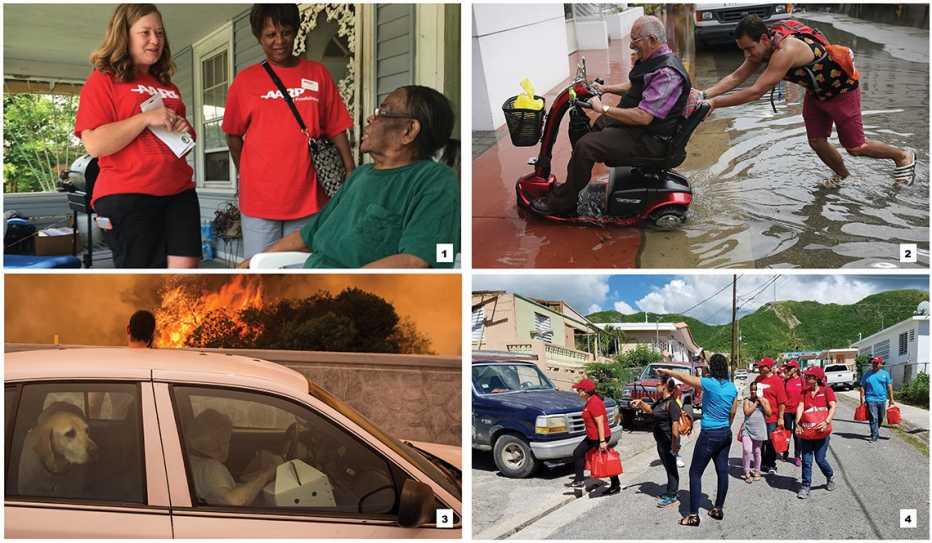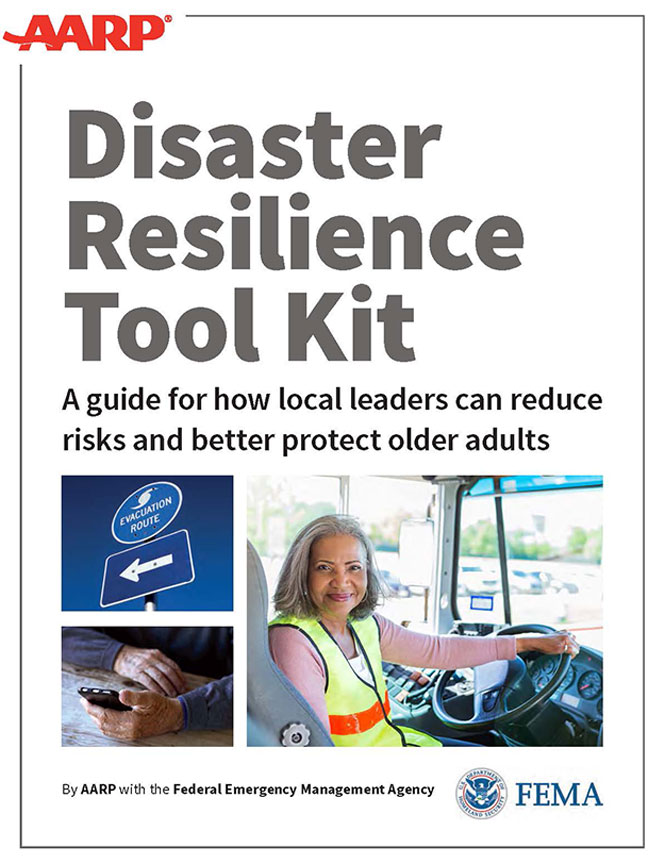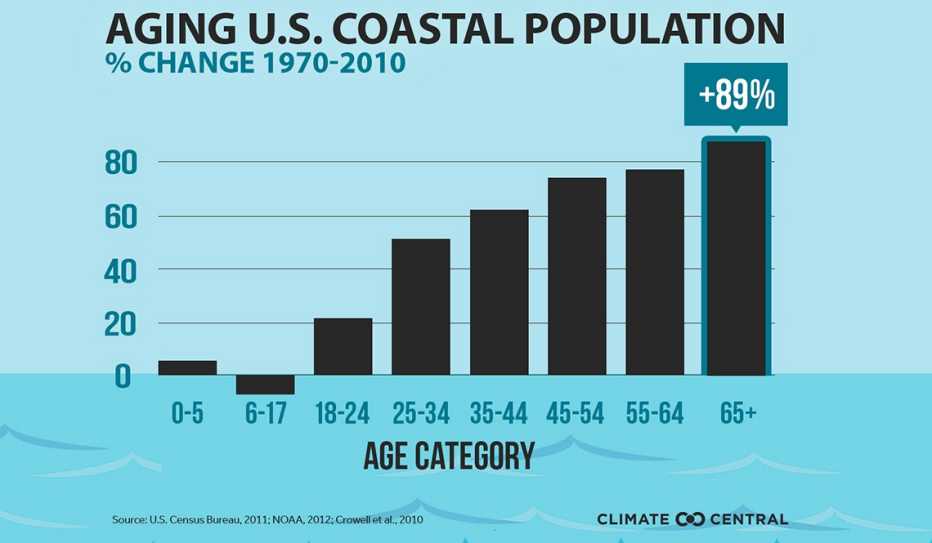AARP Hearing Center
When hazards — whether natural or human-made — strike, the consequences tend to be harder on older adults than on younger age groups.


The Numbers Are Revealing
See page 39 of the AARP Disaster Resilience Tool Kit for sourcing.
- Although people age 75 or older made up about 6 percent of the population in the city of New Orleans in 2005, they accounted for 50 percent of those who died that year as a result of Hurricane Katrina.
- In Northern California’s 2018 Camp Fire, 71 of the 84 identified fatalities were of people age 60 or older.
- When Hurricane Sandy struck the New York tristate area in 2012, nearly half of the fatalities were among people age 65 or older. When Hurricane Ian struck Florida in 2022, of the 87 people killed by the storm, and for whom an age or approximate age was released, 61 were at least 60 years old. Eighteen of them were in their 80s, and five were in their 90s.
- According to the Texas Department of State Health Services, people age 60 or older accounted for 60 percent of the 246 deaths that resulted from subzero temperatures and an extended statewide power outage during a February 2021 winter storm. (On February 17, the temperature dropped to minus 5.98 degrees in Jacksonville, Texas, where the normal February low is about 40 degrees.) All but a handful of the storm related fatalities were due to hypothermia.
Contributing Factors
Some of the reasons older residents are at a disproportionately high risk during emergencies and disaster:
- Older adults often have mobility difficulties that make it harder to get out of harm’s way. They often lack access to transportation. They might be socially isolated, with no friends or family nearby to help. They may be reluctant to leave a pet behind.
- Older adults without a cell phone or internet access lack an essential information and communications resource in this online era. According to AARP’s 2021 Tech Trends report, 15 percent of people age 50 or older do not have access to any type of internet service, and 60 percent say the cost of high-speed internet is a problem. As a result, many older people are unable to get real-time information about changing weather or emergency conditions, available resources or how to find help.
- Many older adults lack the financial means to prepare for disasters or relocate. The 2019 median income of older adults was $27,398. Among all people age 65 or older who reported income that year, 12 percent reported less than $10,000.
- More than half of Americans age 50 or older have no emergency savings. Many are on fixed incomes and lack the available cash to stock up on food and prescriptions (which can be costly), let alone to make their home more disaster resistant.
Relocation Isn't Possible Without Resources
The wealth of many older homeowners is often based on the equity in their homes. In such cases, an individual’s or couple’s financial security is even more entwined with the impact of a disaster. The property owners might want to make a permanent move to a safer neighborhood or dwelling but simply can’t afford to.
- In some coastal areas, current and anticipated rates of sea level rise have depressed property values and increased property taxes and the cost of homeowners’ insurance. For older adults with limited disposable income, the cost of increased or new insurance — or new assessments in a multifamily condominium building for needed maintenance or structural improvements — can be prohibitive, further exposing them to financial challenges when disaster hits.
- Because many older adults own their homes outright, they are less likely to have flood insurance, which is required by many lenders in flood-prone areas but optional for people without a mortgage.
- Older homes in many parts of the United States don’t have air conditioning because, until recently, it was rarely or never needed. Retrofitting a home for a whole-house cooling system — and running one — is expensive. Many people, including older adults, just don’t have the money, strength or skills needed to purchase, lift and install even one window-unit air-conditioner.
- Heating a home can be similarly challenging. In 2015, approximately 1.6 million people age 50 or older who were the heads of their households could not afford the heating fuel, electricity or natural gas necessary to heat their homes. As a result, their fuel deliveries were discontinued, or their natural gas or electricity disconnected.
Increasing Risks
According to an online fact sheet from the U.S. Department of Health and Human Services Office of the Assistant Secretary for Preparedness and Response, “Factors like climate change, globalization, and increased urbanization can bring disaster-related risks to greater numbers of people.”
Increasingly intense weather events affect older adults differently than other groups and impact segments of the older adult population unevenly, influenced by factors such as race, health, income and geography as well as the lack of public and private investment (or post-disaster aid) in a community.
- Low-income individuals and people of color are often highly vulnerable to the impacts of weather-related disasters due to inadequate housing and risk-exposed locations — as residents of all ages in New Orleans’ Lower Ninth Ward discovered during Hurricane Katrina.
- Lower-income residents are more likely to live near industrial facilities, increasing the danger of toxic leaks resulting from storms or similar disasters. Low-income people, including many retirees, are more likely to live in manufactured homes (formerly referred to as mobile homes), which offer less protection from the elements than conventional housing.
- The legacies of race-based zoning, covenants, redlining (the practice of systematically denying home loans based on race, faith or ethnicity), and highway projects that displaced residents and destroyed neighborhoods mean that certain communities — often those of color — are less likely to have parks, green spaces or tree canopies that cool temperatures and absorb water runoff.
The Days After a Disaster
Get the Free Guide
The AARP Disaster Resilience Tool Kit was created for local leaders, government staff, aging services professionals, and community advocates and volunteers.


Many residents — and especially older ones — are at risk even when they escape harm during a disaster. After the storm or immediate dangers have passed, older residents and low-income households can quickly spin into a downward spiral caused by the environmental hazards and structural damage present in their new reality.
- Rescues can be hard to come by due to the demand for services and access challenges.
- When the power goes out and stays out in hot climates or during heat waves, mold and mildew take over homes, medicines cannot be refrigerated, and clean water becomes a scarce resource. When the power goes out and stays out in cold climates or during extreme cold snaps, pipes burst and frostbite (and death) are serious risks.
- Researchers found higher death rates among nursing home residents during the weeks after hurricanes Katrina in 2005 and Irma in 2017. Among the causes were the poststorm heat exposure caused by power outages and the resulting lack of air-conditioning.
- In 2021, in the middle of the global COVID-19 pandemic, several nursing home residents died, and more than 800 others suffered in hot, crowded, unsanitary conditions when they were relocated to an ill-equipped warehouse before Hurricane Ida struck Louisiana.
- Disrupted routines and displacement can adversely impact a person’s physical and mental health. A 2011 study showed that in four hurricanes, death rates were higher among nursing home residents who were evacuated than among those who sheltered in place. A likely cause was the “transfer trauma” associated with being evacuated.
- Repair assistance can be impossible to secure due to the demand for contractors, a shortage of supplies and, for some, a lack of home ownership documents. (See page 27 for more about that.) The need to request emergency assistance online is a challenge for people without access to the internet.
- Older people are a frequent target of fraudulent contractors who capitalize on distressed residents’ desperation. These realities pose fraught choices for older residents (and for those who serve them) and underscore the need to reduce every community’s overall risk.
Rising Waters


From 1970 to 2010, U.S. coastal regions saw an 89 percent increase in the number of residents age 65 or older. (See the graph above.) As a result, the nation’s oldest adults routinely find themselves in the path of rising seas, and a growing number of nursing homes and assisted living facilities are now in flood-prone coastal areas.
Florida is projected to be the hardest-hit state in coming decades, with 2 out of every 3 of its care-facility beds located in areas that will likely experience occasional or frequent flooding from now to 2050. That’s 67 percent higher than those at risk today.
Coastal homes are at risk for flooding due to hurricanes and major storms. But even “sunny day” flooding — which has become common in Miami Beach due to seawater rising up through sewer grates during high tides — can impede the ability of residents to go about their daily business and errands. (The city has been installing pump stations and raising many of its streets.) The confluence of demographic shifts, population growth along the coasts and rising sea levels means such dangers are likely to become commonplace.
Sources: Climate Central and NPR.
This article is an excerpt from Part 2 of the AARP Disaster Resilence Tool Kit. Order, download or view the publication online to read more content from the chapter, including information about the consequences of extreme heat, the added hazards of homelessness, and accessing a tool for calculating a community's vulnerabilities.
Page published November 2022


























































